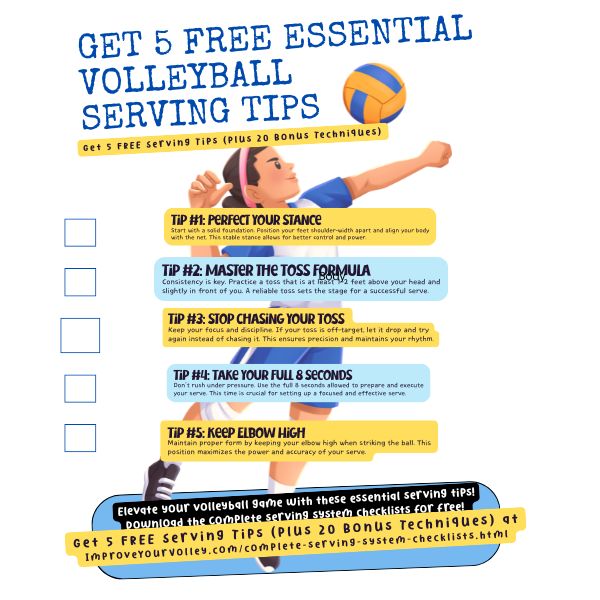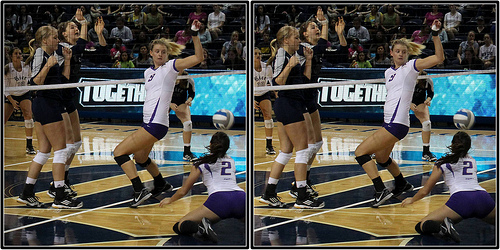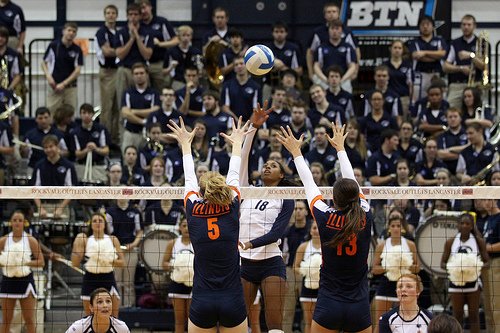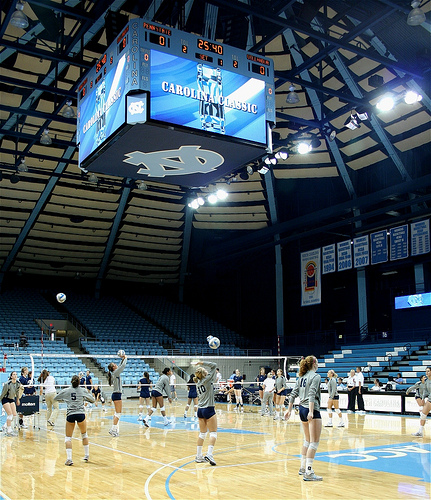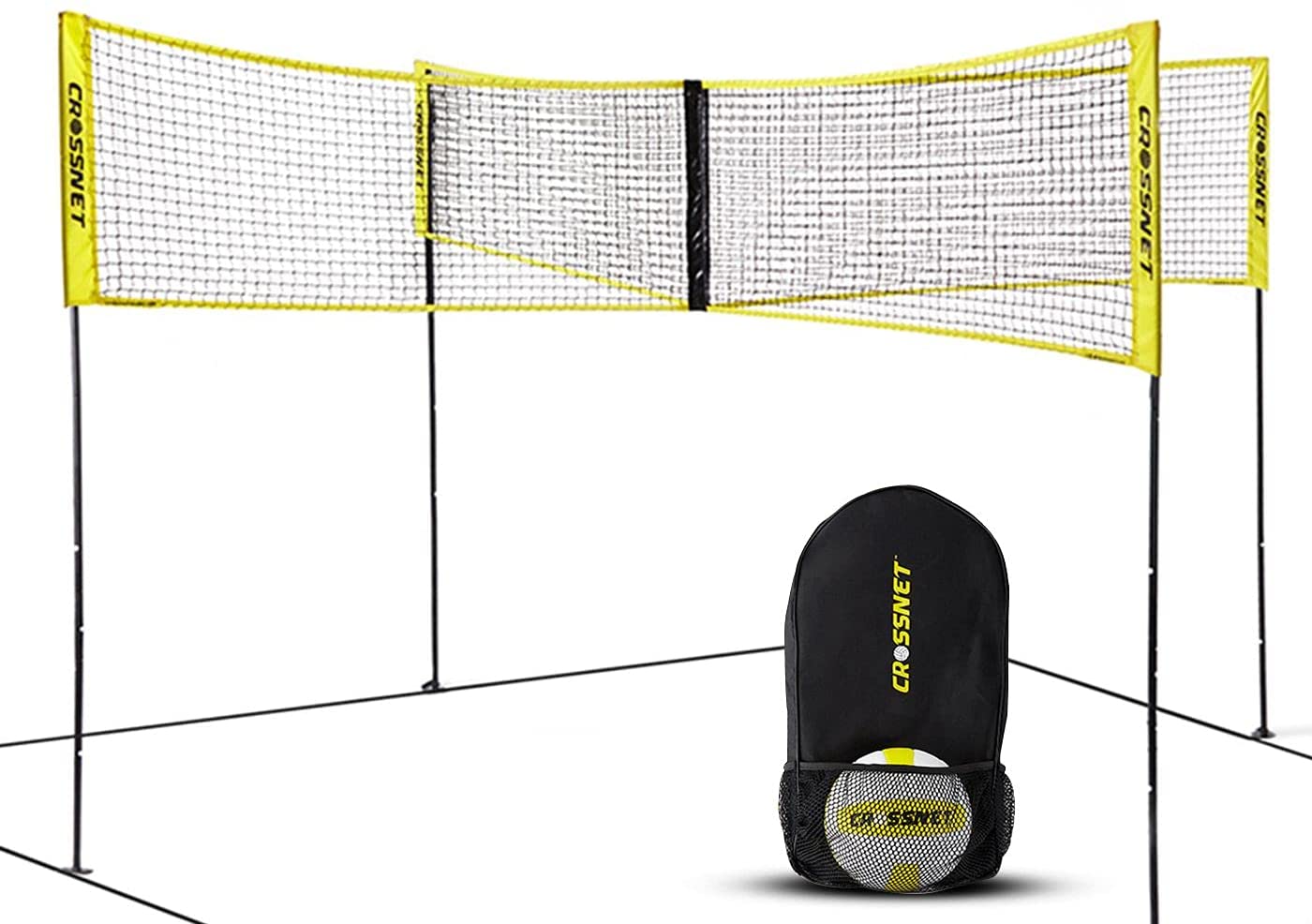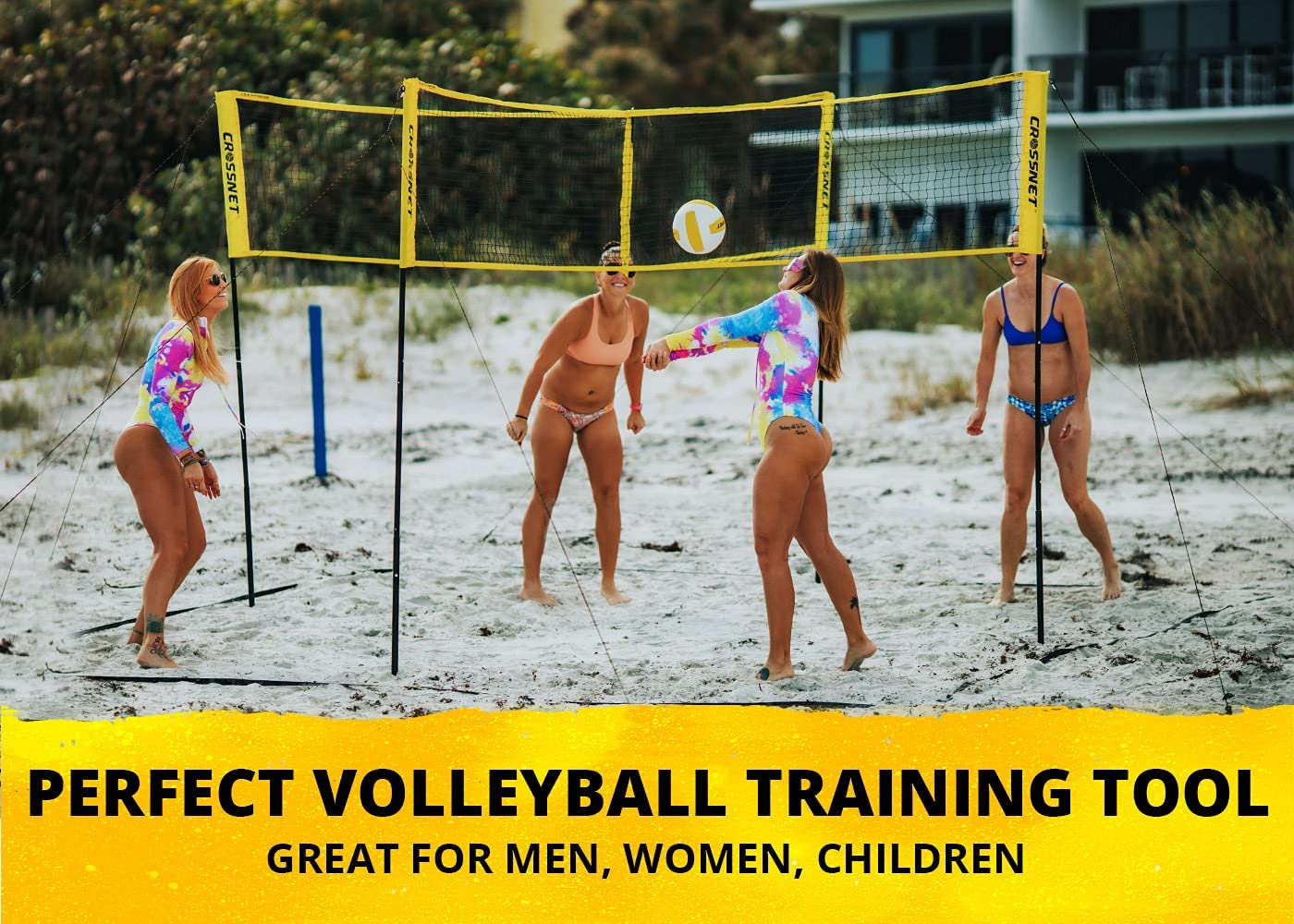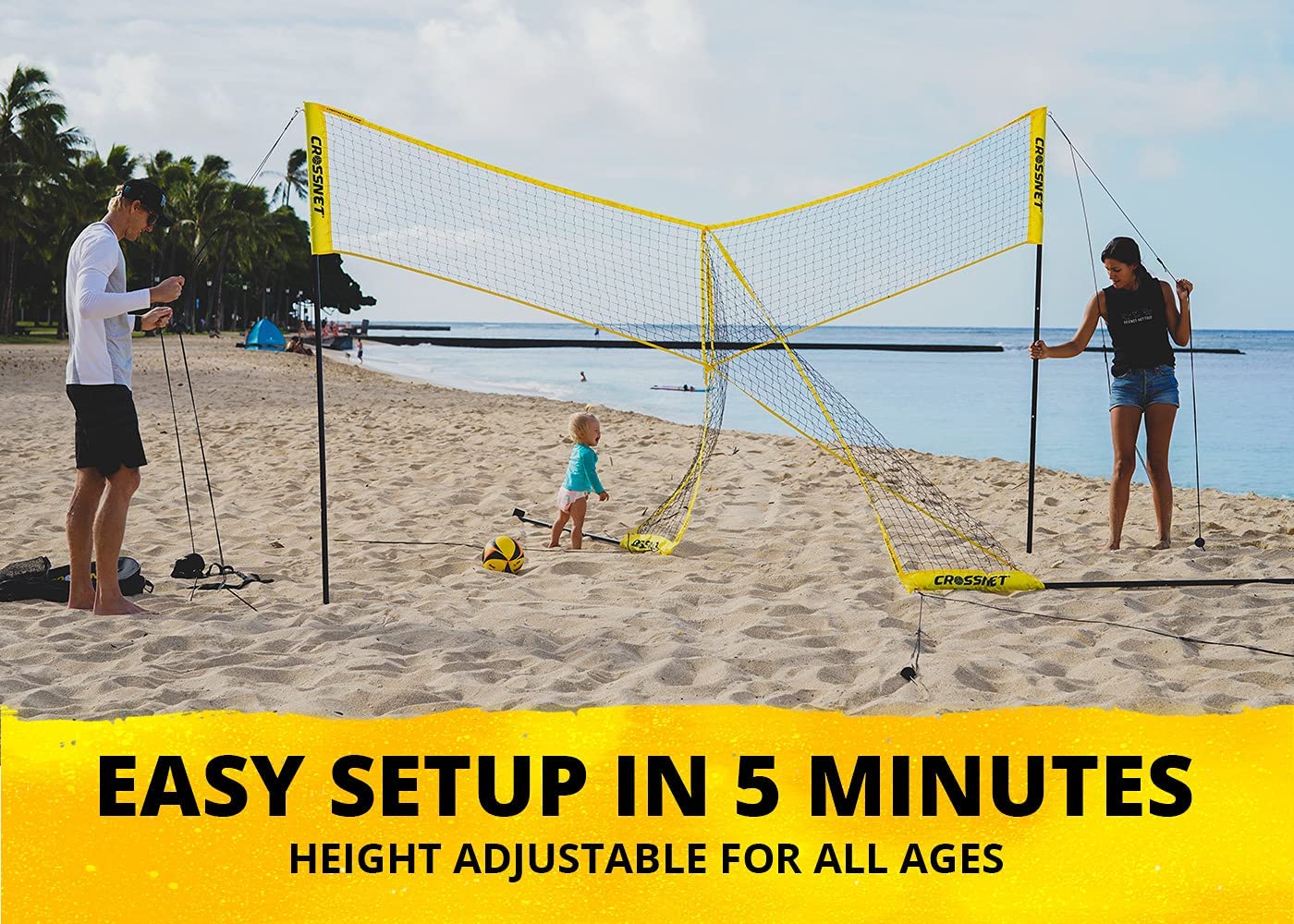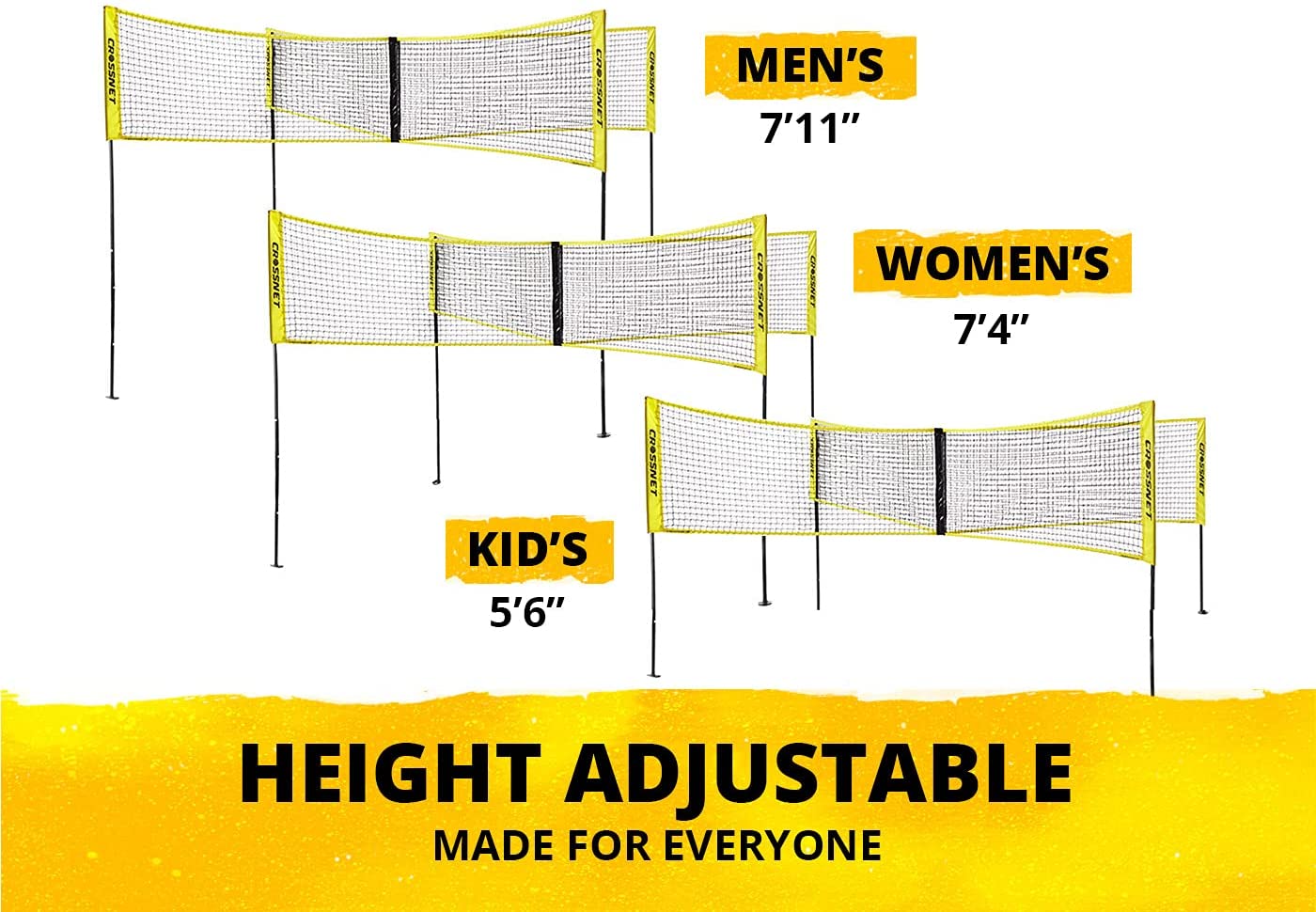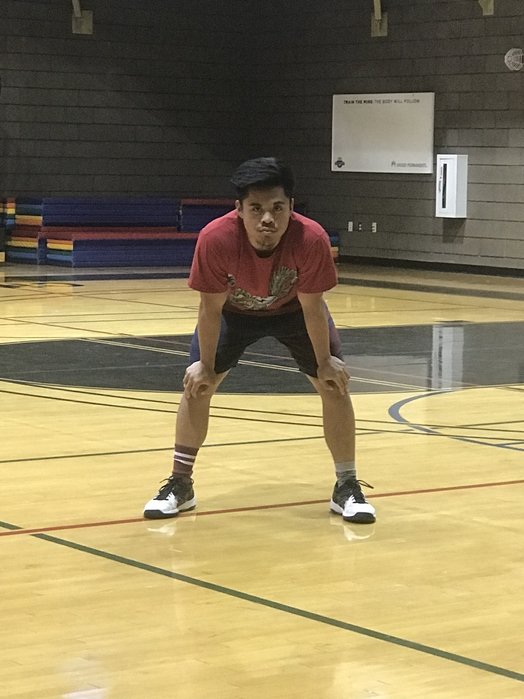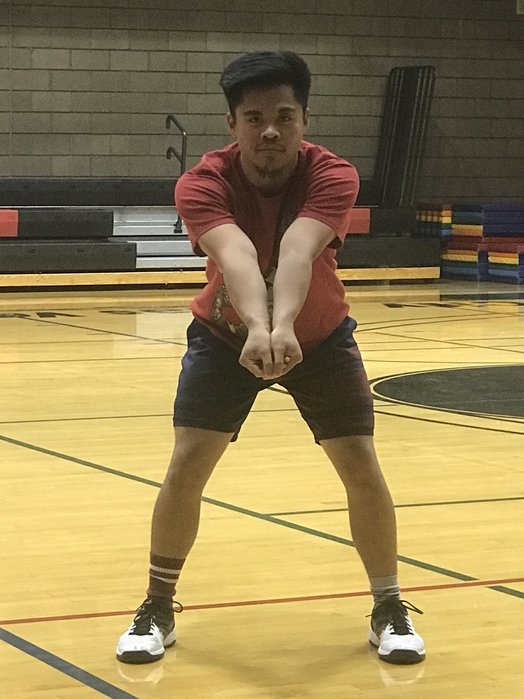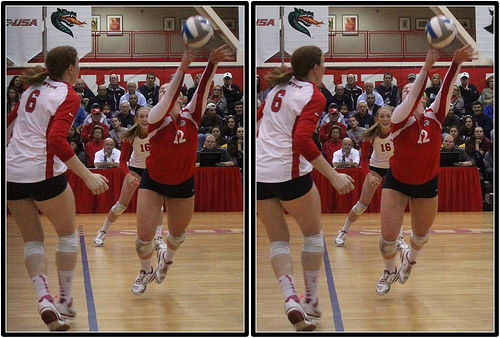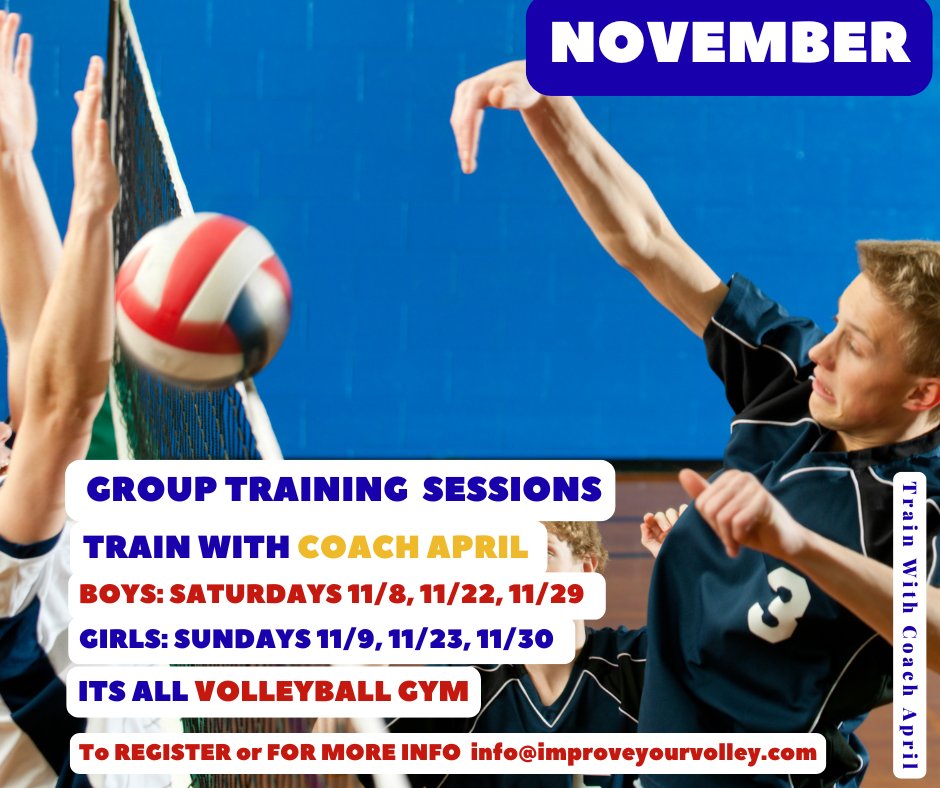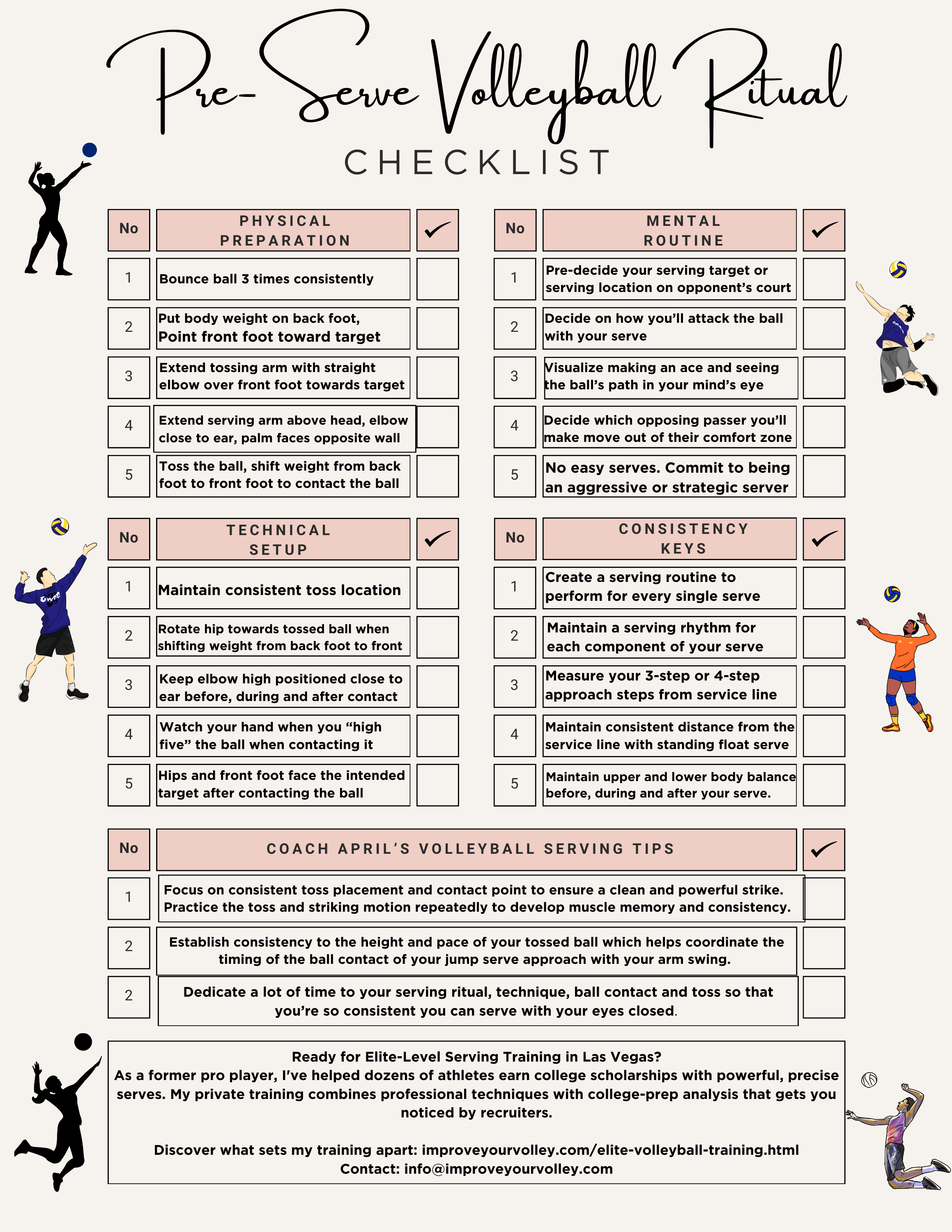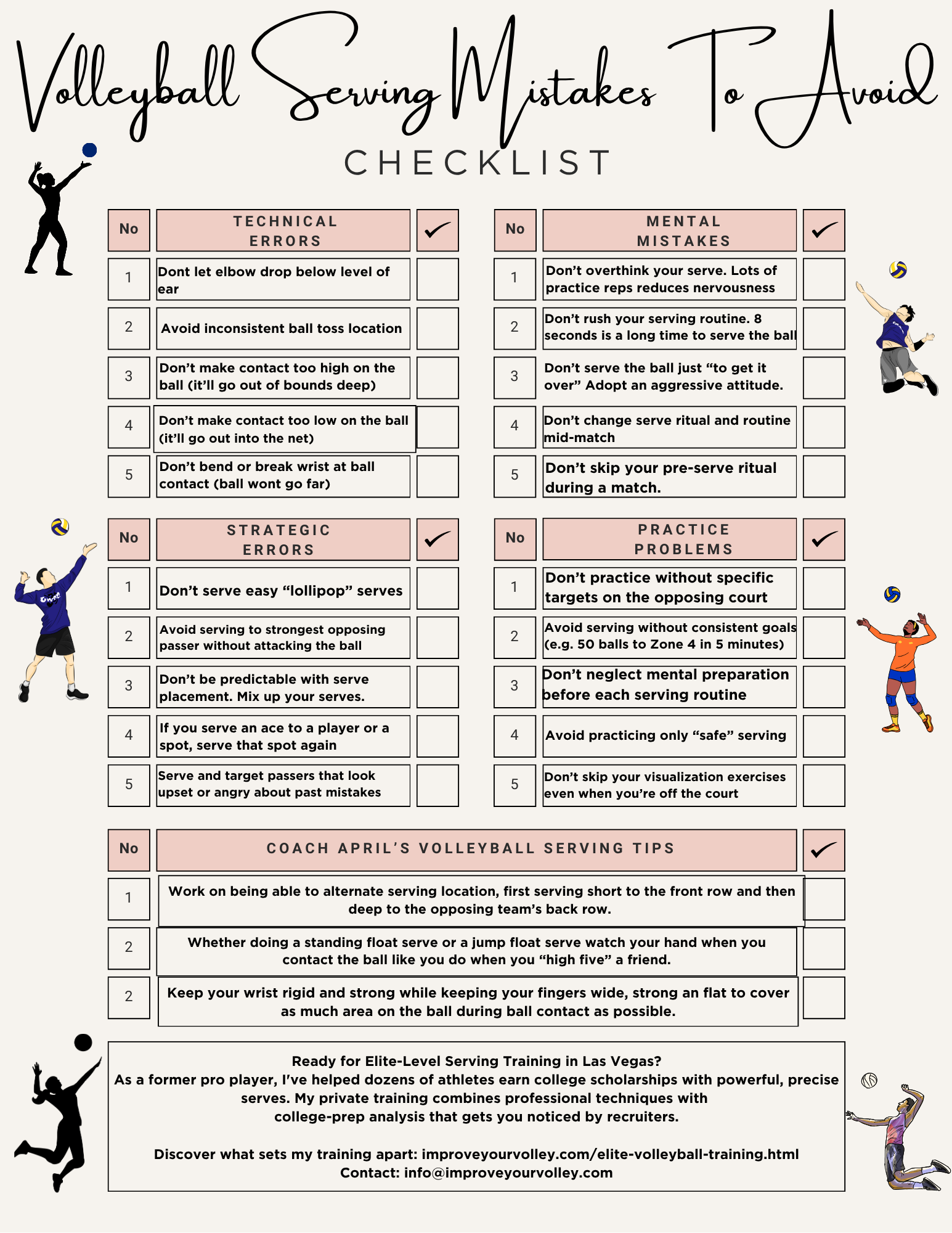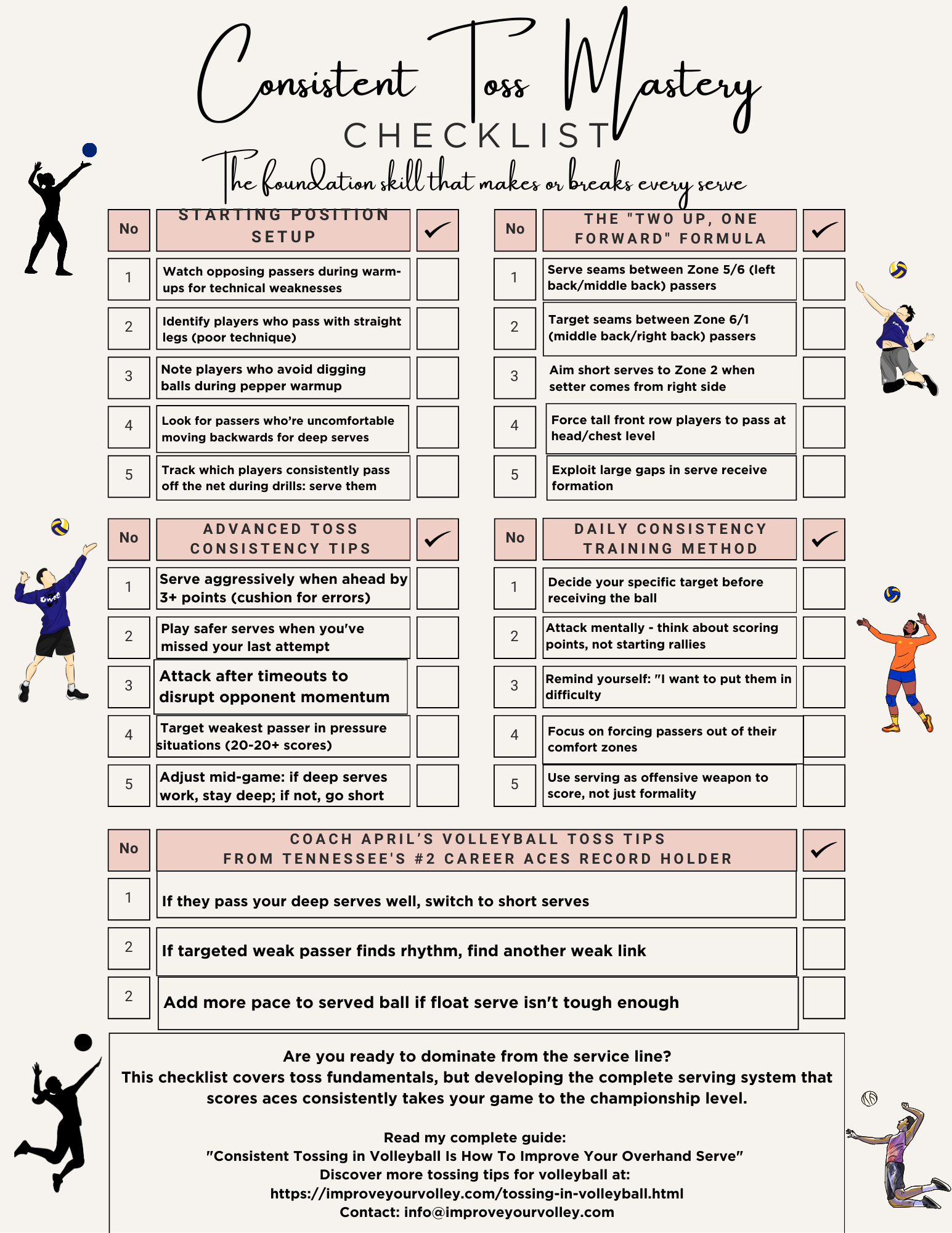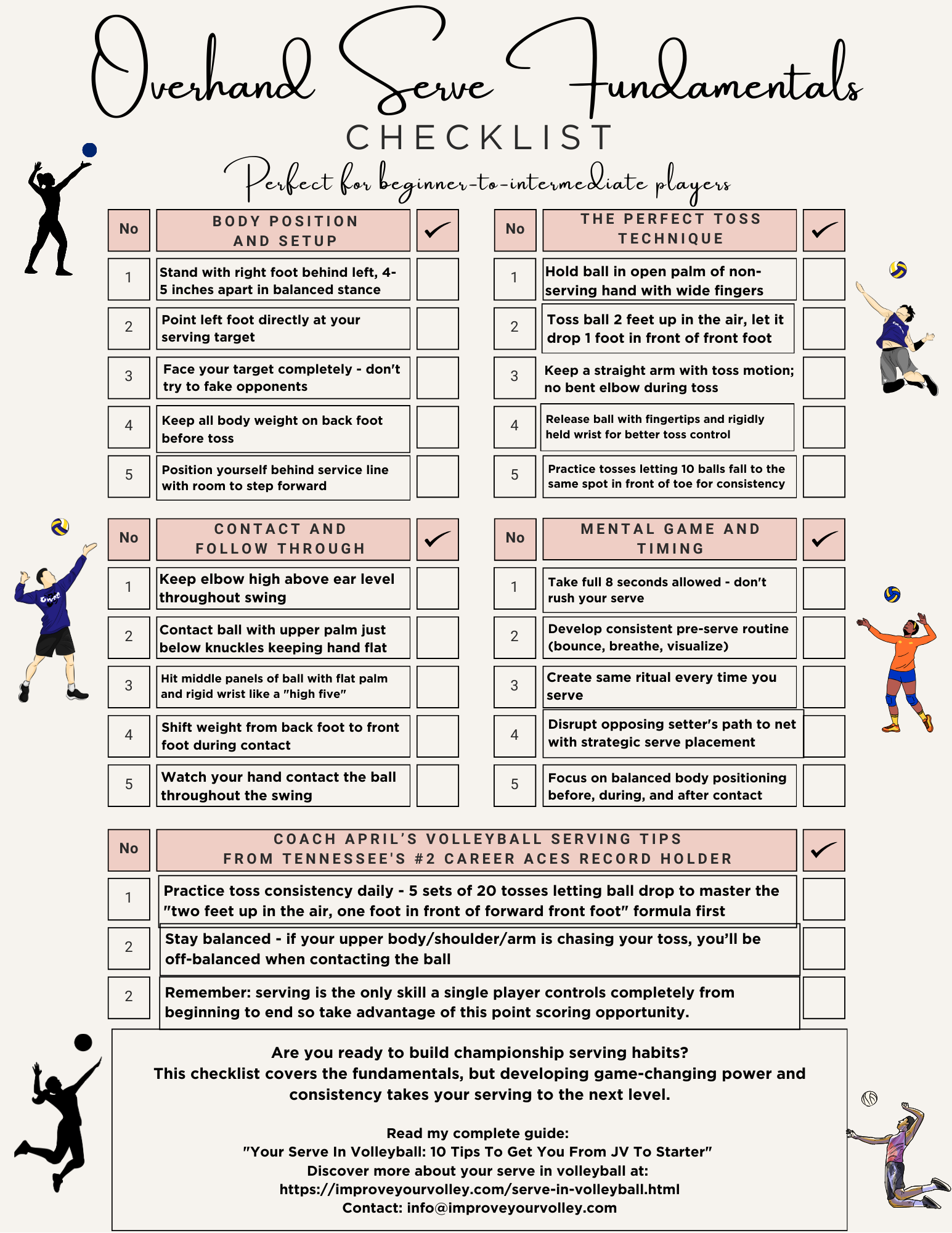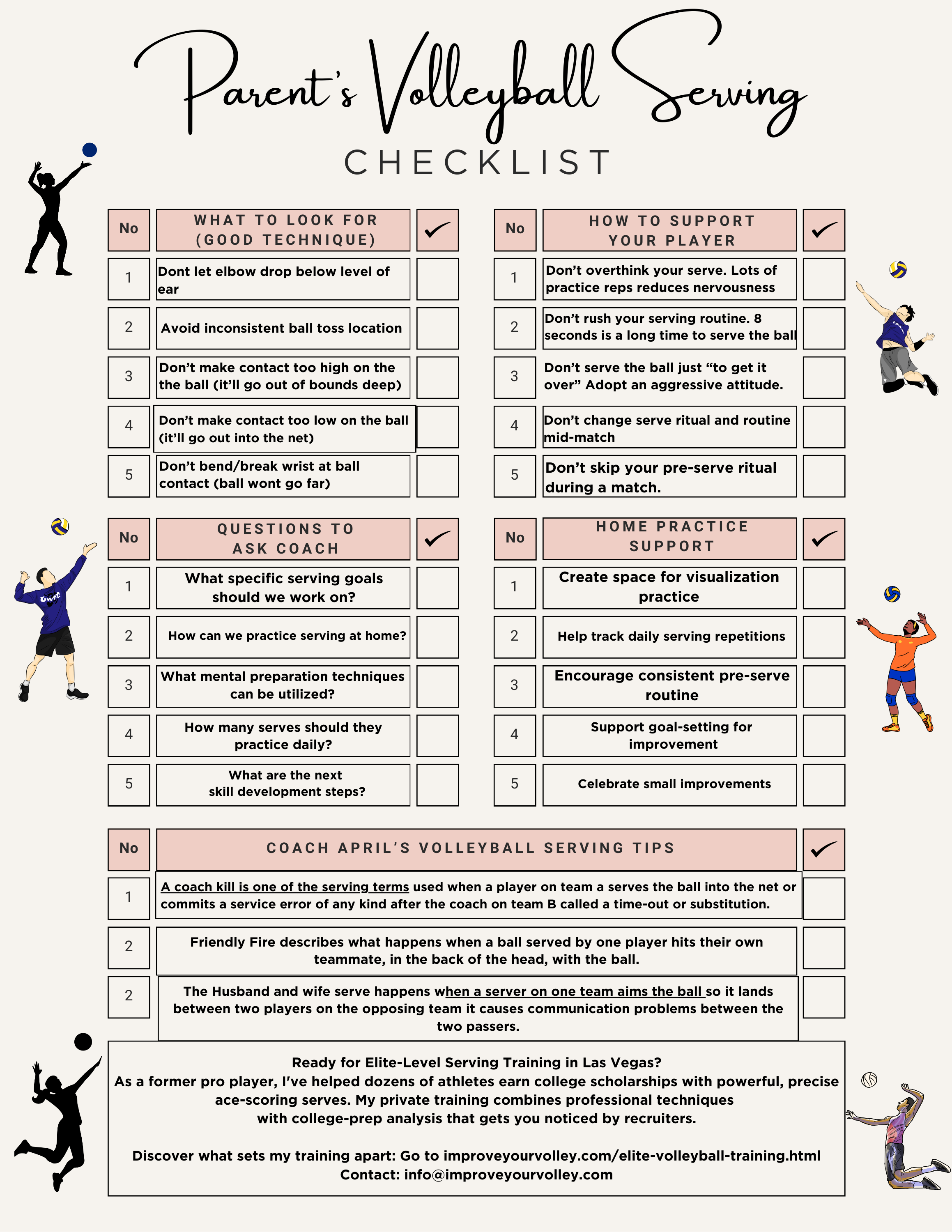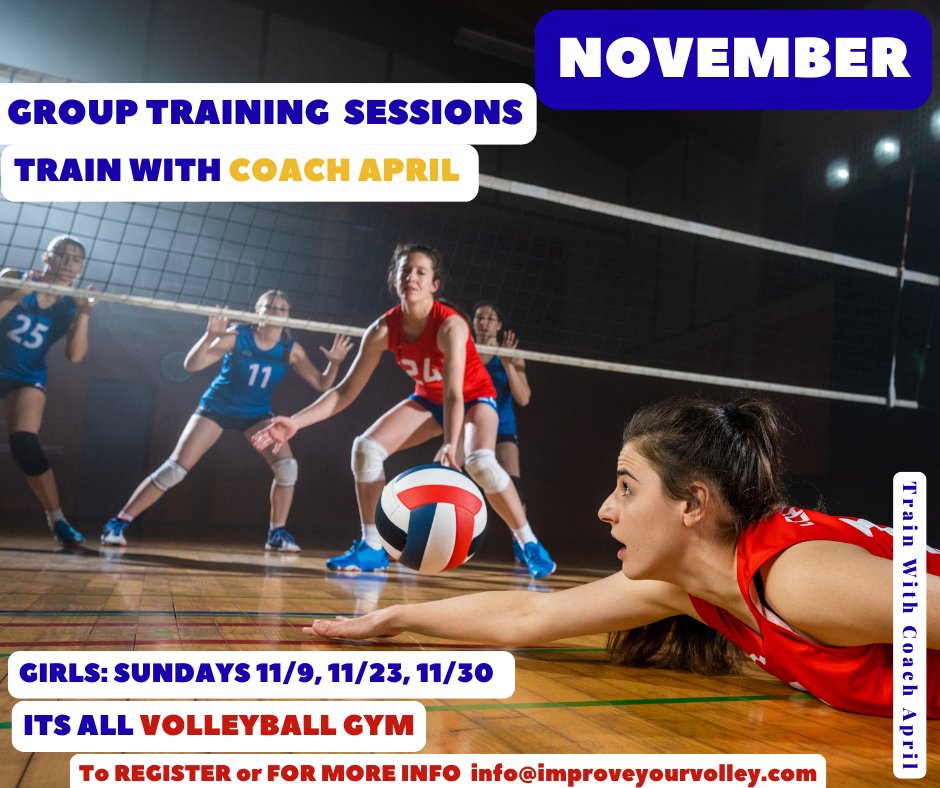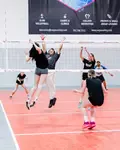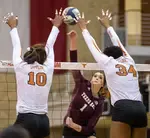- Improve Your Volleyball with Coach April
- How To Play Volleyball
- How To Communicate in Volleyball
How To Communicate in Volleyball
Five Things To Say in Defense
When you learn how to communicate in volleyball there are things you can say to your teammates in defense which will help the team identify where the opposing hitters are that could possibly get a set.
Learning how to communicate in volleyball is an important part of this sport but there are specific occasions while on defense when team communication skills are absolutely essential.
While on defense, you and your team should first be communicating with each other, loudly about these three things...
- who the attackers are and what jersey numbers they have
- where the attackers are on the opposing team and what they could possibly be hitting
- where the setter is
...before the referee blows the whistle to start play.
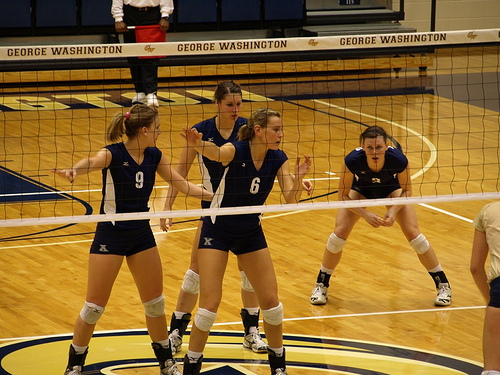 How to Communicate in volleyball. Xavier Front Row Blockers Calling Out The Opposing Hitters (photo by LT Mayers)
How to Communicate in volleyball. Xavier Front Row Blockers Calling Out The Opposing Hitters (photo by LT Mayers)In the photo above the Xavier blockers wearing the #6 and #9 jerseys show how to communicate in volleyball defense by pointing out with their fingers and at the same time shouting out to their teammates that there are three possible attackers in the front row on the opposing team.
The picture above of the Illinois State Redbirds blockers shows the player wearing the #2 jersey is showing another example of how to communicate in volleyball by holding up her two fingers indicating to her teammates behind her that there are two hitters in the front row that the setter could set the ball to.
It also means that if there are only two hitters front row then the setter is front row also and could be one of the players who could tip the ball or hit the ball over as well.
 Volleyball Quote Shirts Available at Volleybragswag on Etsy. Mistakes Are Lessons Learn From Them. Click to shop!
Volleyball Quote Shirts Available at Volleybragswag on Etsy. Mistakes Are Lessons Learn From Them. Click to shop!#2 is doing her job by communicating this important information to her teammates so they won't be surprised by a front row setter tipping the ball over her team's block.
How To Communicate in Volleyball
Call Out The Hitter Tip
What about calling out the opposing team's hitter when they appear to be tipping the ball?
The more games and matches and tournaments that a player plays in, the more they will get used to watching the movement of an opposing hitter's arm during their hitting motion so that they can better anticipate what type of spike the hitter will make and where that spike will probably go.
A crafty hitter will disguise the fact that they are going to tip by executing the same arm movement they use when they spike the ball.
The difference is that at the very last minute, at the highest point in their spike jump, they will slow down their wrist movement to tip the ball over the block instead of spiking it.
As a player on defense you want to always, always call out "tip!" to your teammates, when you see the hitter do this.
The more games and matches and tournaments that you play in, the more you will get used to watching the movement of an opposing hitter's arm during their hitting motion and you'll be able to better anticipate what type of spike the hitter will make and where that spiked ball will probably go.
How To Communicate in Volleyball
Make Pepper Challenging
This is what we used on the third tip on how to communicate in volleyball is a way to develop your individual communication skills in practice.
You definitely need to learn to recognize early, the telltale signs of when a player is going to tip the ball.
Before practice during your pregame pepper warmup drill with your partner make sure to mix up your "attack" so that you hit five or six balls hard in a row, then you tip the ball followed by three or four more hard hits, then another tip that's to the side of your partner, then five or six hard hits, then a short ball to the other side of your pepper partner.
By mixing up the attack in your pepper warm up drill, you mimic, or in other words you copy or you reenact the different types of hits that you and your teammates will see or will have to defend against in your next game.
It's counterproductive to get into a comfortable easy set-pass-hit rhythm during your pepper, because the volleyball game consists of different rhythms and unexpected spikes, and hits off the block and digs made when players are off balance so these are precisely the things pepper partners want to prepare themselves for during their pepper warmup.
The game is played at a certain intensity and if you don't practice or pepper at that intensity or higher you will react, read and play slower in the game.
Why do we do that?
1. That way when you get in a game, it will be easier to play at that intensity level.
2. In a game is the opposing team going to make it easy for you to dig their balls by hitting right at you?
I doubt it.
They are going to do everything they can to keep the ball out of your reach.
Guess what? That means for you to keep the ball out of each other's reach as well.
Both pepper players, should challenge each other so neither of you knows what "attack" is going to come next.
Then when each of you do see the attack from your partner, you should get in the habit of calling out what you see.
Is your partner tipping the ball? Call out "tip" as you go for the ball.
This way
- you are practicing how to read the spiker's
- you are working on increasing your quick reflexes in defense
- you are working to improve the reaction time to the ball
Ultimately, the faster you recognize when someone is going to tip, the faster you learn how to communicate information quickly to your teammates.
How To Communicate in Volleyball
Give Court Directions
Here's a scenario.
If a volleyball player is off the court and she is attempting to hit a down ball from either the right side or left side of the court, then the only way the volleyball can be hit back into the court without touching the antenna is for the ball to travel at a cross court angle.
Since there is no way the down ball attacker can hit the ball down the line without hitting the antenna why stay at the net to block the line?
There are two things players can be communicating to each other at this point.
Coach April Chapple's Volleyball Passing Tips For Youth Volleyball Players
The outside blockers should call "down ball" so the front row blockers can transition quickly off the net to run a play, instead of staying at the net to block.
The back row defense along with the blockers should be yelling "cross court dig!" or "Watch the cross court hit!" or "Dig the angle" so the team's defense can shift a few steps to the right or left depending on where the ball is coming from to quickly defend the down ball hitter's cross court attack.
If a player concentrates on how the play is developing and reads the play correctly they will call out what play is going to happen before it happens.
Many times in club and high school volleyball when this situation occurs one or two defenders are left defending a part of the court that the ball will never come to.
This is a waste of time, energy and manpower and ultimately will cost your team valuable points.
By talking about what the opposing team's hitter is doing, the whole team knows that it will be useless to have anybody defending down the line and that they all need to shift the block, if the team blocks down balls, but more importantly shifts the diggers so they dig the cross court ball.
How To Communicate in Volleyball
Free Ball Defense
Many times a volleyball player has to turn their back to the net to play a ball whether they are running off the court or not.
If this is their third contact, the minute you see the player bend their knees while they have their back turned you should yell "free ball" because you know the ball is about to come over the net.
The sooner you do this, the sooner your team can transition back into your team's free ball defense.
But if you wait until the player has already contacted the ball AND its on its way over the net, that's too late and you have wasted precious time that could have been used to ALREADY be in your free ball passing position.
You could have run a faster offense and caught the opposing team off guard.
While on defense, players need to learn to watch or to "read" the spiking arm of the attacker for indications as to how the hitter intends to hit the ball, where they intend to hit it, how high or how low they intend to hit the ball and how hard or how soft they plan to contact the ball.
If the hitter's arm is below their waist, then they couldn't possibly be preparing to overhand spike the ball, so everyone on your team should be seeing that the ball won't be hit and that the player intends to underhand pass the ball over the net so everybody should be calling out "free ball!" loudly.
How To Communicate in Volleyball:
Where Do You Go Now?
Okay here's where you need to go now! There are three options:
- Learn more about Smart Tactics by clicking the Related Links below. .
- Follow the suggested reading on our Sitemap page Learning How To Play (Sitemap)
- Or visit the pages in the Communication section in the drop down menu at the top of the page to get started.
If your athlete struggles with consistent serve receive, gets subbed out, or is overlooked for playing time—this is the fix you’ve been looking for.

Struggling with passing consistency?
I help talented passers tired of getting pulled from games because of inconsistent serve receive skills BUILD passing confidence without expensive private lessons using the same 3-step system that's helped dozens of my athletes get recruited.
Download my eBook for $17.99 and start building the passing confidence that keeps you on the court—and gets you seen by college coaches.
From Lady Vol to Legend: Coach April Produces Powerful Passionate Players...is that you?
What Are You Looking For?
Click to Download Your Pre Serving Ritual Mastery Checklist pdf:
🎯Volleyball Pre Serving Ritual Guide -
Players! Learn How To Transform Your Serve from Weak to Weapon
Click to Download Your Parent's Volleyball Serving Checklist pdf
🎯Parent's Volleyball Serving Checklist Guide
Parents! Help Your Player Develop Championship Serves (Even If You've Never Played)

Hi there!
Thanks for stopping by. Hope you learned something today that will help you reach your volleyball goals.
Be sure to subscribe to my email newsletter so you can learn more each week!
Stay strong! Stay motivated!
-Coach April

SUSCRIBE to my email newsletter below!
 Click to learn more about the weekly volleyball classes and clinics or email info@imrpoveyourvolley.com for information
Click to learn more about the weekly volleyball classes and clinics or email info@imrpoveyourvolley.com for informationCongratulations to my seven Boys-18s Vegas Volley club players who played in two state championship finals yesterday, the 3A and 5A State champinship finals at Sunrise Mountain High School.
TOURNAMENT CHAMPIONS!
A-1 Vegas Volley VBC
In It To Win It Tournament
May 2 - 4, 2025 Tournament
Gold Medalists
18s Premier Division
Vegas Volleyball's Unsung Heroes: Celebrating Moms with Peace Love Volleyball Shirts
Ready to energize your volleyball mom journey?
Subscribe to my 'Producing Powerful Passionate Peaceful Players' email list above on ImproveYourVolley.com.
You'll receive energy-boosting tips, exclusive insights from me, Coach April Chapple on maintaining momentum in volleyball.
Let's power up the Vegas volleyball scene together!
Recent Articles
-
Tips For Short Volleyball Players: Top Strategies to Beat Big Blockers
Jan 11, 26 11:00 PM
You don't need to be 6 feet tall to dominate at the net. Learn my tips for short volleyball players to use to outsmart bigger blockers and score more points. -
Essential Skills for a Hitter in Volleyball: Tips For Short Attackers
Jan 11, 26 07:05 AM
A short hitter in volleyball can aim the ball for the seam of the block to score since its harder for defenders to block at the net or dig up in the back row. -
10 Hitting Tactics Short Volleyball Players Use Against Big Blockers
Jan 11, 26 06:57 AM
These are 10 hitting tactics that short volleyball players, can rely on hit against and sideout and score against teams with big blockers in the front row.
